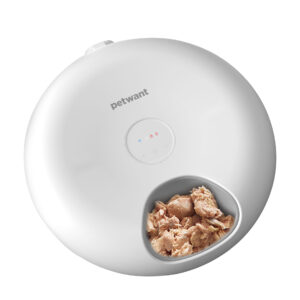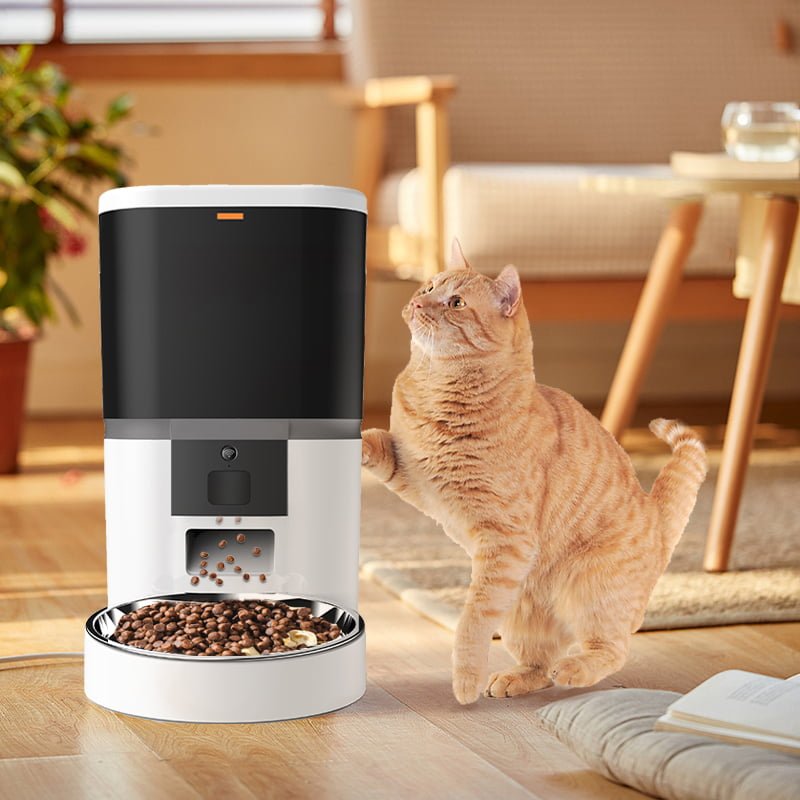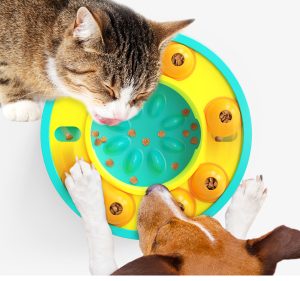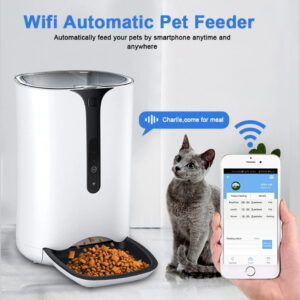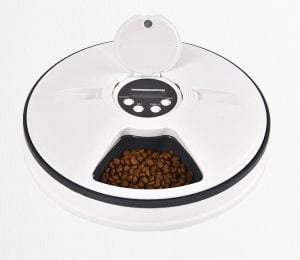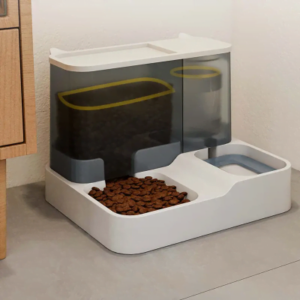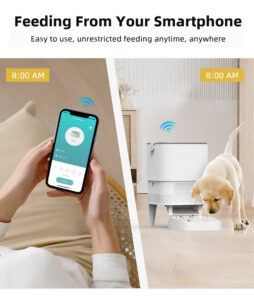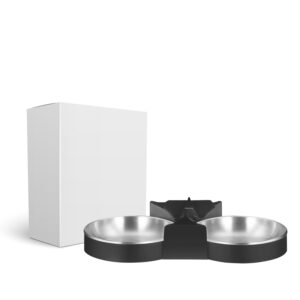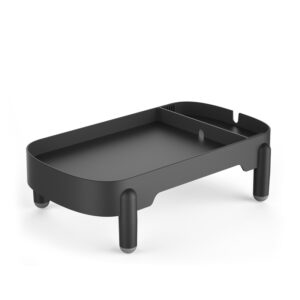Feeding in Multi-Pet Homes: How to Reduce Food Tension
By Gavin Levenstein Updated: 13 May 2025 Editor’s note: This guide was reviewed by a qualified veterinarian and a certified behavior professional for accuracy.
Feeding multiple pets at home can be rewarding—and sometimes tricky. Every pet has its own dietary needs, eating pace, and personality. In shared spaces this can lead to guarding, rushed eating, or scuffles around the bowl. Below you’ll find the calm-meal blueprint we use with families every day: behavior-first steps, smart tools that genuinely help, and simple routines you can put in place this week.
Shop multi-pet feeding solutions ›
—
Quick answers (jump to what you need)
- Separate feeding zones by pet and by height; use baby gates, crates, or shelves for cats.
- Match the feeder to the behavior: microchip/RFID for diet control and food theft; slow bowls/puzzles for gulpers; timed smart feeders for routine.
- Create a predictable schedule; supervise early and fade as pets learn.
- Portion to the pet, not the bowl—use a scale or a connected feeder.
- Train away guarding with distance, calm setups, and positive reinforcement.
- Special diets? Use microchip access or a closed room; avoid free-for-alls.
- Need a fast plan? See “Set up separate feeding zones in a day.”
Jump to FAQs • Compare feeder types • Best feeders
—
Why Food Tension Happens in Multi-Pet Homes
Even in loving homes, mealtime can feel “high stakes” to animals. Common triggers:
- Lack of individual access: pets fear their food will be taken.
- Different eating speeds: fast eaters hover and steal from grazers.
- Unclear structure: unpredictable timing or shared bowls create anxiety.
The fix is twofold: predictable structure + the right tools so each pet can eat in peace.
—
Identify Each Pet’s Dietary and Behavioral Needs
Before you buy anything, observe for 2–3 days:
- Diet type: prescription, weight-management, senior, puppy/kitten, dental-friendly.
- Feeding behavior: grazer, fast eater, anxious, resource guarding.
- Body condition: gaining/losing/steady weight.
- Special cases: diabetic pets, senior pets with mobility or dental issues.
This snapshot will guide your setup and the feeder that fits.
—
Feeding Solutions by Pet Type and Behavior
Two cats with different diets
- Use a microchip/RFID feeder for the prescription-diet cat.
- Feed the healthy cat in a second zone; consider a timed feeder if you avoid free-feeding.
- Start with doors partially closed so neither cat feels crowded.
CTA: Explore Microchip/RFID cat feeders.
Dog that steals cat food
- Elevate the cat’s feeding station on a stable shelf or wall perch the dog can’t reach.
- If needed, add a microchip feeder with a lid to block canine “vacuuming.”
- Feed the dog in a gated area to break the habit quickly.
CTA: See separate feeding stations for cats and dogs.
One grazer + one gulper
- Grazer: microchip feeder or a closed room with a simple bowl.
- Gulper: slow feeder bowl or puzzle feeder to slow pace and reduce bloat risk.
- Stagger start times by 5 minutes to prevent hovering.
CTA: Shop Slow Feeder Bowls and Puzzle Feeders.
Diabetic cat in a multi-cat home
- Scheduled, measured meals via a microchip or timed auto feeder.
- Keep other pets out with access control (microchip lid) or a separate room.
- Log portions; many smart feeders track grams/meal.
CTA: Browse Auto Feeders.
Senior pets or pets with dental issues
- Offer softer textures and wider, shallower bowls.
- Feed away from rambunctious pets; mats help stability.
- Consider slow, small frequent meals with a connected feeder.
—
Microchip vs RFID vs Smart camera/AI feeders (2025 update)
Here’s how to pick based on problems you’re solving:
- Microchip/RFID access feeders
– Best for: multiple cats with different diets; preventing food theft. – Key features: access by microchip or tag; lidded bowl; quiet motor preferred. – Consider if: you need strict diet segregation or have a grazer.
- Smart automatic feeders (app-connected, timed)
– Best for: routine building; portion control; back-to-office schedules. – Key features: programmable schedules; portion by gram; notifications; some have dual bowls. – Consider if: you want app control and consistent timing for one or more pets.
- Camera/AI feeders
– Best for: monitoring who eats and how much; anxiety or medical monitoring. – Key features: ID via camera, meal video, alerts; may be noisier/heavier. – Consider if: you want remote visibility or have complex multi-pet dynamics.
- Gravity feeders (low-tech)
– Best for: single-pet homes or tightly managed rooms. – Consider if: cost is key and you can prevent food theft another way.
Quick tip: For multi-cat homes with diet differences, microchip/RFID nearly always beats camera-only solutions for true access control.
—
Best Automatic and Microchip Feeders for Multiple Pets
Look for these multi-pet features:
- Access control (microchip/RFID) or multi-pet lockout
- App scheduling and portion accuracy (grams/meal)
- Quiet operation and stable anti-tip design
- Capacity suited to your pet sizes and number of meals
- Easy-clean bowls; wet-food compatibility if needed
Popular picks at TailMe:
- Classic Connected Feeder – Dual Bowls
- Elegant Connected Auto Feeder
- Cool Bowl Smart Feeder
- Wet Pet Food Dispenser
- Doggy Slow Puzzle Feeder (for gulpers)
CTA: Compare Auto Feeders and Slow Bowls side by side.
—
Slow Feeders and Puzzles for Fast Eaters
For dogs who inhale meals (and many cats), slow feeders and puzzles:
- Reduce gulping and mealtime tension
- Provide mental enrichment (a calmer pet is less guardy)
- Help weight management by extending eating time
Start easy, then increase difficulty so frustration doesn’t spike. CTA: Browse Puzzle Feeders and Slow Feeder Bowls.
—
How to Separate Cat and Dog Feeding Areas
- Vertical zones: sturdy shelves or high benches for cats.
- Baby gates with cat doors: let cats pass, keep dogs out.
- Crate or pen feeding for excitable dogs to build calm.
- Corners, alcoves, or quiet rooms: reduce traffic and defensiveness.
- Floor mats and non-slip stands to anchor bowls.
Example image alt text to use on this page:
- “RFID microchip cat feeder preventing food theft in multi-cat home.”
- “Raised cat feeding shelf behind baby gate; dog fed in adjacent room.”
—
Step-by-Step: Create a Calm Mealtime Routine
You’ll need: two+ feeding stations, chosen feeders, mats, optional gates/crate.
1) Map zones: assign one station per pet; add height for cats if needed. 2) Pick feeders by behavior (access control for theft; slow bowls for gulpers). 3) Set a simple schedule (e.g., 7:30 and 18:30). 4) Measure portions (scale or connected feeder). 5) Stage entry: release the calmest pet first; wait 30–60 seconds between pets. 6) Supervise for 3–7 days; remove bowls when finished. 7) Reward calm departures from stations; no crowding. 8) Fade supervision once everyone eats and leaves reliably.
CTA: Need help choosing? Find your setup in 60 seconds.
—
Calorie and Portion Mini-Guide
A quick way to sanity-check amounts:
- Resting Energy Requirement (RER) = 70 × (body weight in kg)^0.75
- Adjust for life stage and activity (ask your vet).
Example: 4 kg cat ? RER ˜ 70 × 4^0.75 ˜ 200 kcal/day (then adjust). Use a kitchen scale or a connected feeder for accuracy.
Widget idea: add a simple “calories per day” calculator here and a downloadable “Mealtime Peace Plan” checklist for your household.
Helpful resources:
- WSAVA Global Nutrition Toolkit (wsava.org)
- American College of Veterinary Behaviorists (dacvb.org)
—
Back-to-Office or Holidays: Keep Routines Steady
- Use smart schedules that continue even if Wi-Fi drops.
- Prep pre-weighed wet-food trays for sitters.
- Leave a printed “Mealtime Peace Plan” with zones, times, and portions.
- Holiday guests? Feed pets in bedrooms or crates away from the bustle.
—
Short demos (video ideas + transcripts)
- Microchip feeder setup in a multi-cat home (30–45 sec)
Transcript: “Tap ‘Add Pet,’ pair the microchip, test the lid, and place the feeder on a quiet shelf. Now only Tinker can access her prescription meals.”
- Slow bowl for fast-eating dog (20–30 sec)
Transcript: “Same amount of food, different bowl. Watch how the maze slows Buddy so he finishes calmly—no more bowl-guarding afterward.”
—
Case studies: What worked in real homes
- Sarah: “My dog kept stealing the cat’s renal diet. We elevated the cat’s meals and added a microchip feeder. In 48 hours the stealing stopped.”
- Jamal: “One grazer, one gulper. A microchip feeder for the grazer and a puzzle bowl for the gulper ended the chasing within a week.”
—
FAQs: Multi-Pet Feeding Problems Solved
How do I stop my pets from fighting over food?
Feed in separate zones, start meals at the same time, and remove bowls when finished. Use microchip/RFID feeders for access control and slow bowls for gulpers. Supervise for a week and reward calm behavior.
Can one automatic feeder work for two cats?
It can time meals for both, but it can’t prevent one cat from eating both portions. For different diets or food theft, a microchip/RFID feeder per cat is best. Dual-bowl connected feeders help when diets are identical and both eat together calmly.
Are microchip feeders worth it for multi-cat homes?
Yes if you have different diets, a grazer, or a food thief. They reduce stress by guaranteeing access for the right pet only, which often stops guarding and hovering.
How do I feed pets with different diets?
Separate zones plus access control. Use microchip/RFID feeders or feed one pet in a closed room/crate. Label bowls and schedule. For medical diets, avoid communal grazing.
What’s the best way to separate cat and dog feeding areas?
Go vertical for cats (shelves/perches) and use baby gates with cat doors. Feed dogs in a gated room or crate so everyone can eat without interruption.
Do slow feeder bowls help with food aggression?
They help by slowing the “problem eater,” reducing arousal and competition. Pair them with separate stations and positive reinforcement for best results.
How often should I feed multiple cats?
Most adult cats do well on 2 meals/day. Grazers may prefer multiple small meals via timed or microchip feeders. Kittens need more frequent feeding (3–4x/day). Keep the schedule consistent.
How can I feed a grazer and a fast eater in the same house?
Give the grazer a microchip feeder and the fast eater a slow/puzzle bowl. Start meals a minute apart, supervise, and remove bowls when each pet finishes.
—
Which feeder fits your situation? (quick guide)
- Different diets or a food thief ? Microchip/RFID feeder per pet
- Back-to-office routine, predictable portions ? Connected auto feeder
- Fast eater, burps, or anxiety post-meal ? Slow feeder or puzzle
- Wet-food or mixed diets ? Check wet-food compatible dispensers
- Need visibility while away ? Smart feeder with camera/alerts
CTA: Compare options in Auto Feeders or chat with us.
—
Related products for multi-pet peace
- Classic Connected Feeder – Dual Bowls
- Elegant Connected Auto Feeder
- Cool Bowl Smart Feeder
- Wet Pet Food Dispenser
- Doggy Slow Puzzle Feeder
Browse more in Auto Feeders and Slow Feeder Bowls.
—
Sources and further reading
- World Small Animal Veterinary Association (WSAVA) – Global Nutrition Guidelines
- American College of Veterinary Behaviorists – resources on resource guarding
- AAHA Nutritional Assessment Guidelines
—
Images on this page should include descriptive alt text such as:
- “Microchip cat feeder identifying the correct pet in a multi-cat home.”
- “Separate dog and cat feeding zones with baby gate and elevated shelf.”
Note for readers: If you’d like a personalized plan, try our 60-second setup quiz above. We’ll email your “Mealtime Peace Plan” and product picks based on your pets’ needs.

